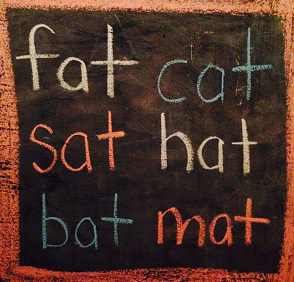Teaching phonics and rhyming to a child develops their phonological awareness skills – which play an important part of becoming a good reader.
Phonological awareness refers to an individual’s awareness of the phonological structure, or sound structure, of words. Phonological awareness is an important and reliable predictor of later reading ability. (Thanks Wikipedia)
Where to start
Children encounter rhyming from a very early age. From the lullabies we whisper in their ears from birth, to the nursery rhymes and fabulous books we read them as toddlers, rhymes make up much of what they hear for the first few years!
So it won’t be totally unfamiliar to them when you start teaching phonics and rhyming to your child.
If you’re wondering how to define ‘rhyme’ to your child, you could explain that “rhyming words have the same sound at the end“.
As a young child, they may not be able to repeat the definition if asked, but they will certainly be able to demonstrate rhyme once they have been immersed in rhyming games and activities!
Teaching Rhyming to Children
There are many games and activities to do when you start teaching rhyming to children. Here are some basics things to do that don’t require many resources.
Tip: Start with rhyming one syllable words. Identifying the word ending is made easier with fewer sounds in a word!
- Body Parts – Point to a part of your body and ask your child to name as many words as they can that rhyme with it. For example – leg: peg, beg, meg, keg.
- Point out – In your child’s room (or any room with lots to point to!), say a word and ask your child point to something that rhymes with it. For example if you a near a book, ask “Can you point to something in this room that rhymes with ‘look’?”
- I Spy – Instead of ‘something that begins with…” the game becomes “I spy, something that rhymes with _____!”. And there you have a quick, fun lesson on teaching phonics and rhyming!
- Books – Your child is never too old (or too young) to settle into a good book with you. Many of our favorite books have wonderful rhyme – including Ten Little Fingers and Ten Little Toes, Room on the Broom, The Cat in the Hat, Hairy Maclary from Donaldsons Dairy and more.
- Songs – Some of the best old songs have really simple rhyme. Such as Incy Wincy Spider, Twinkle Twinkle Little Star, Hickory Dickory Dock and more!
- Worksheets – Our Rhyming Pictures worksheet will give your child practice recognizing and identifying rhyme with pictures (ideal for toddlers and pre-reader/writers!). If you get stuck for sounds, our Phonics Sounds Chart – Word Ends and Phonics Worksheets will give you some more examples of simple word end sounds to use in your games and activities.
